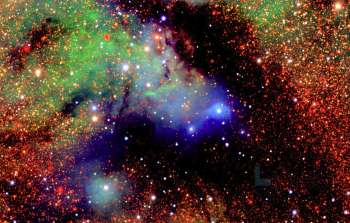sci17022 — Announcement
DECam Plane Survey Data Release: Catalogs and Images Now Available
October 31, 2017
Eddie Schlafly (Lawrence Berkeley National Lab)
A new publicly available data set offers a wealth of information on the structure of the disk of the Milky Way and its interstellar medium.
The DECam Plane Survey (DECaPS), which uses the Dark Energy Camera (DECam) to observe the southern Galactic plane (dec < -30 degrees), has released data covering roughly one-third of the Milky Way’s disk: a swath within 5 degrees of the Galactic plane that extends over 1000 square degrees of the sky through Galactic longitudes between 5 degrees and -120 degrees. The survey reaches a depth of 23.7, 22.8, 22.2, 21.8, and 21.0 magnitudes in the g, r, i, z, and Y bands, roughly suitable for detecting main-sequence turn-off stars at the distance to the Galactic center through a reddening of 1.5 magnitudes E(B-V).
The data release includes images and catalogs. The full catalogs contain more than twenty billion detections of two billion objects, mostly corresponding to highly reddened stars deep in the Galactic disk. All of the images making up the survey can be browsed interactively through the DECam Legacy Survey viewer and are available through the NOAO Science Archive.
Some images from the DECaPS Data Release. Hover your mouse over the image to pause the slideshow. Click the image to step through a larger version of the slideshow (with links to the viewer for further exploration).
The DECam Plane Survey
The DECam Plane Survey was designed to measure the fluxes of billions of stars in the southern Galactic plane to reveal the three-dimensional distribution of dust in the Milky Way. In concert with Pan-STARRS1 (PS1) observations of the northern Galactic plane, the survey results allow a full 360 degree map of the dust in the Milky Way.
DECaPS is not just an extension of PS1, however. It is significantly deeper than other wide-area surveys of the Galactic plane, reaching stars roughly one magnitude fainter than PS1 in individual images. The DECaPS pipeline is optimized for crowded fields of point sources, allowing precise photometry even in the inner Galaxy where the huge number of stars blend together in the typical 1" seeing obtained by DECaPS.
Nor is DECaPS just about dust. By studying many stars, the structure of the Milky Way’s disk can be characterized in detail. Color-magnitude diagrams from the survey show a rich array of stellar populations that vary from place to place within the Galaxy. The DECaPS catalog is only a first step intended to enable many different scientific analyses of the survey.
Each part of the survey footprint was observed three times, usually on different nights, using the same tiling of the sky developed for the DECam Legacy Survey. This strategy was designed to enable precise photometric calibration, but it also provides some limited variability information about all of the observed stars. Observations for the survey took place over 22 nights from March 2016 to May 2017. The large etendue and low downtime of the DECam/Blanco system made this survey efficiency possible. Further details on the survey are available in a preprint by Schlafly et al. (2017).
DECaPS Images
Color images from DECaPS can be interactively browsed through the DECam Legacy Survey viewer, built by Dustin Lang. The three colors show the g, r, and z bands. Both the actual observations and “model observations” generated from the DECaPS catalogs and the pipeline-estimated PSF can be viewed, providing an immediate sense of the accuracy of the modeling. For example, compare the actual observations with the best-fit models in the viewer.
All of the images making up the survey are also available through the NOAO Science Archive (select all images with Program Number 2016A-0323 or 2016B-0279, PI: Finkbeiner).
Catalogs
The DECam Plane Survey catalogs were constructed using a custom pipeline optimized for crowded stellar fields. The pipeline follows in the tradition of DAOPHOT, simultaneously fitting for the positions and fluxes of all of the stars in each image. This fit is performed by linearizing the problem and passing the optimization off to a large, sparse, linear-least-squares optimizer. In the densest regions, this can require simultaneously fitting the positions and fluxes of 60,000 stars per 1024x1024 pixel region.
Each DECaPS image is independently analyzed. In order to provide multiband information, single-image catalogs are matched together, and detections within 0.5” of one another are considered to be detections of the same star. All of the detections of the same object are then grouped together to provide average photometry and astrometry of each star in each band. Both the single-image and band-merged catalogs are available at the survey web site.
About the Announcement
| Id: |
ID
sci17022
|
